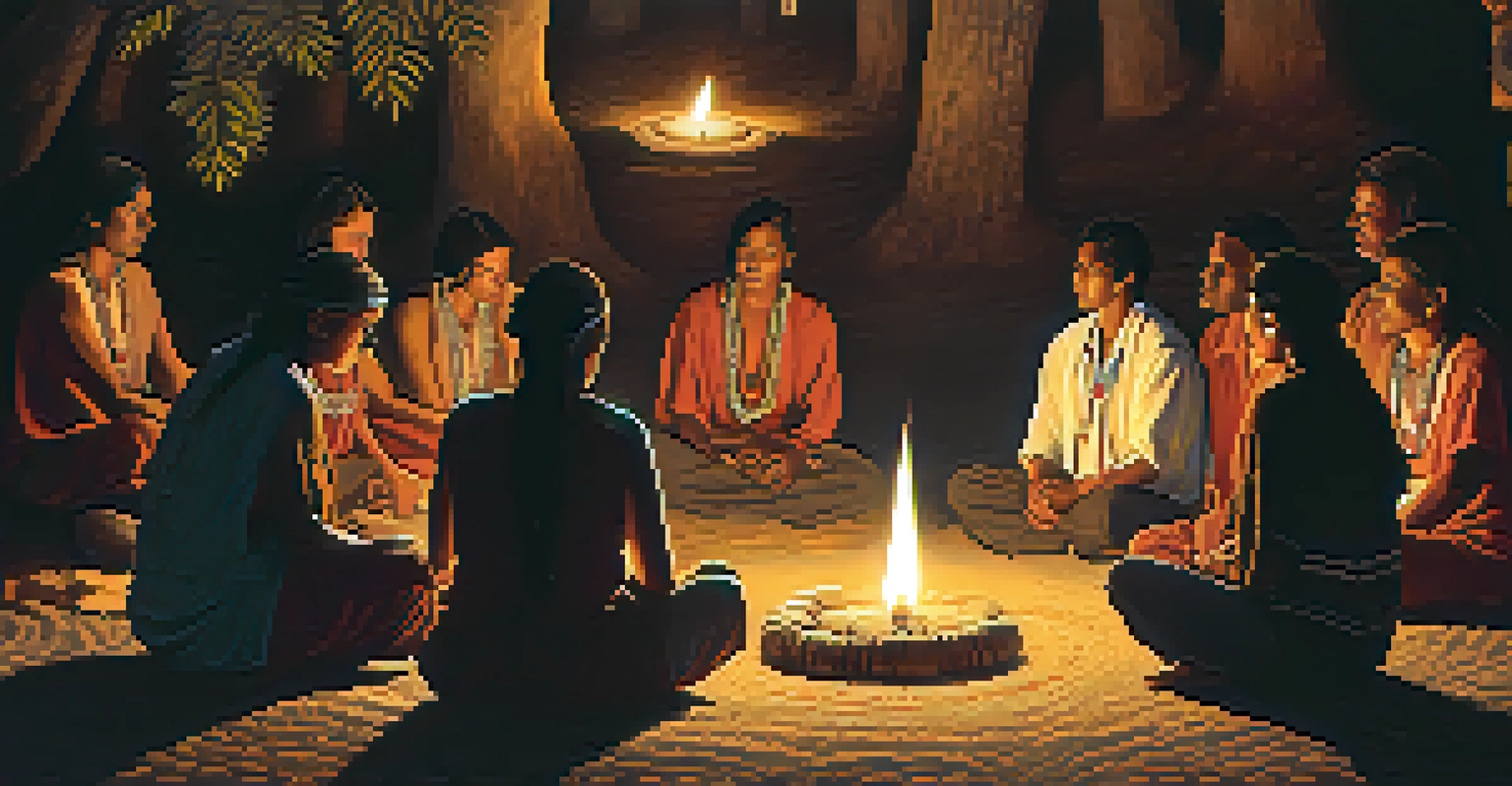Cultural Perspectives on Peyote and Dream Experiences

Understanding Peyote: A Brief Overview
Peyote is a small cactus native to Mexico and the southwestern United States, well-known for its psychoactive properties. This cactus contains mescaline, a substance that induces altered states of consciousness, often leading to vivid dream-like experiences. For many Indigenous cultures, peyote is more than just a plant; it holds spiritual significance and is integral to rituals and healing practices.
Psychedelics can help us connect to the spiritual realm and provide insights that can transform our understanding of ourselves and our place in the universe.
The use of peyote has a rich history that dates back thousands of years. It has been used in religious ceremonies by Indigenous groups, particularly the Native American Church, which incorporates it into their spiritual practices. By understanding its cultural roots, we can appreciate the depth of meaning behind peyote and its impact on the dream states of those who partake in it.
In various cultures, peyote is viewed as a bridge between the physical and spiritual worlds. This perspective fosters a unique relationship with the dream experience, often seen as a pathway to deeper insights and understanding of oneself and the universe.
The Role of Peyote in Indigenous Spirituality
In many Indigenous cultures, peyote serves as a sacrament that facilitates communication with the divine. It is often consumed during ceremonies that focus on healing, guidance, and community bonding. These rituals create a shared space where participants can explore their inner thoughts and visions, often leading to profound dream experiences.

For instance, during a peyote ceremony, individuals may recount dreams or visions that arise during their journey. These experiences are not merely personal; they contribute to a collective understanding of spiritual truths and community identity. This highlights how peyote acts as a catalyst for communal dreaming and shared wisdom.
Peyote's Spiritual Significance
Peyote serves as a sacrament in Indigenous cultures, facilitating communication with the divine and fostering communal bonding during healing ceremonies.
As participants navigate their dream landscapes, they often find clarity and purpose, which can be transformative. This spiritual awakening is a testament to the power of peyote, not just as a plant, but as a vessel for cultural expression and individual exploration.
Dreams as a Portal: Peyote-Induced Experiences
Many individuals report that peyote enhances their dream experiences, making them more vivid and meaningful. The psychedelic properties of mescaline can blur the lines between waking and dreaming, creating a rich tapestry of imagery and insight. This phenomenon allows users to explore their subconscious mind in a profound way.
The dream is the small hidden door in the deepest and most intimate sanctum of the soul.
Dreams experienced under the influence of peyote often involve symbolic elements that reflect personal and cultural narratives. For example, a dream may contain ancestral figures or elements of nature that resonate with the dreamer’s identity. This symbolism can lead to significant revelations about one's life and purpose.
Moreover, the emotional intensity of these dreams can catalyze healing and self-discovery. Participants often emerge from these experiences with a sense of renewal, equipped with new perspectives that can influence their waking lives.
Comparative Perspectives: Peyote and Other Psychoactives
While peyote is unique, it shares similarities with other psychoactive substances like psilocybin mushrooms and ayahuasca. Each of these substances has distinct cultural contexts and effects, yet many users report similar enhancements in their dream states. This raises intriguing questions about the nature of consciousness and how different substances can facilitate dream exploration.
For example, ayahuasca, a brew from the Amazon, is known for its powerful visionary experiences, often leading to cathartic dreams. Similarly, psilocybin can evoke deep emotional responses and transformative dream narratives. Comparing these experiences can help us understand the broader implications of psychoactive use in various cultures.
Dreams Enhance Healing Insights
Psychoactive experiences with peyote often lead to vivid dreams that promote emotional and psychological healing through personal and shared insights.
Ultimately, these substances reveal the universal human desire to explore the subconscious and connect with the spiritual realm. Whether through peyote, ayahuasca, or psilocybin, the journey into dream states offers insights that resonate across cultures.
Modern Perspectives on Peyote Use
In contemporary society, the use of peyote has become a topic of interest beyond Indigenous cultures. As more people seek alternative methods for personal growth and healing, peyote is gaining recognition for its potential therapeutic benefits. This shift invites a reevaluation of traditional practices and their relevance in today's world.
However, this modern interest also raises ethical questions about cultural appropriation and the commercialization of sacred practices. It is essential to approach peyote use with respect and understanding, acknowledging its Indigenous roots and the significance it holds for those communities. Engaging with these practices should be done thoughtfully and inclusively.
As the dialogue around peyote continues to evolve, it provides an opportunity for greater awareness and appreciation of Indigenous cultures. This can foster a deeper connection to the spiritual and dream experiences that peyote offers.
The Intersection of Dreams and Healing
Dreams have long been associated with healing in many cultures, and peyote enhances this connection. Participants often report that the insights gained from their peyote-induced dreams can lead to emotional and psychological healing. By confronting fears and unresolved issues in their dreams, individuals can experience catharsis and transformation.
In Indigenous healing traditions, dreams are considered a vital source of guidance. Peyote ceremonies often include discussions about the dreams experienced during the journey, allowing participants to process and integrate their insights. This communal sharing reinforces the idea that dreams can be a powerful tool for collective healing.
Modern Interest and Ethical Concerns
The growing interest in peyote for personal growth raises ethical questions about cultural appropriation and highlights the need for respectful engagement with Indigenous practices.
As more people explore the healing potential of dreams, the role of peyote in this process becomes increasingly significant. Integrating spiritual practices with psychological healing can create a holistic approach to well-being.
Future Directions: Research and Understanding
As interest in peyote continues to grow, research into its effects on dreams and consciousness is gaining momentum. Scientific studies are beginning to explore the psychological and neurological impacts of peyote, shedding light on its potential benefits and risks. This research could provide valuable insights into how peyote influences dream experiences and overall mental health.
Moreover, understanding the cultural significance of peyote is crucial for responsible research and usage. Collaborating with Indigenous communities allows for a more nuanced approach to studying peyote, respecting its traditions while exploring its potential benefits. This partnership can lead to a greater understanding of how peyote-induced dreams can contribute to personal and collective healing.

In the coming years, we can expect to see more interdisciplinary research that bridges psychology, spirituality, and cultural studies. This holistic approach will deepen our understanding of peyote, dreams, and the human experience.